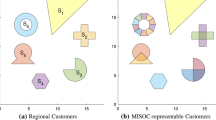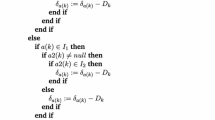Abstract
In this study, we consider a semi-desirable facility location problem in a continuous planar region considering the interaction between the facility and the existing demand points. A facility can be defined as semi-desirable if it has both undesirable and desirable effects to the people living in the vicinity. Our aim is to maximize the weighted distance of the facility from the closest demand point as well as to minimize the service cost of the facility. The distance between the facility and the demand points is measured with the rectilinear metric. For the solution of the problem, a three-phase interactive geometrical branch and bound algorithm is suggested to find the most preferred efficient solution. In the first two phases, we aim to eliminate the parts of the feasible region the inefficiency of which can be proved. The third phase has been suggested for an interactive search in the remaining regions with the involvement of a decision maker (DM). In the third phase, the DM is given the opportunity to use either an exact or an approximate procedure to carry out the search. The exact procedure is based on the reference point approach and guarantees to find an efficient point as the most preferred solution. On the other hand, in the approximate procedure, a hybrid methodology is used to increase the efficiency of the reference point approach. The approximate procedure can be used when the DM prefers to see locally efficient solutions so as to save computation time. We demonstrate the performance of the proposed method through example problems.
Similar content being viewed by others
References
Ahuja R.K., Ergun Ö., Orlin J.B. and Punnen A.P. (2002). A survey of very large-scale neighborhood search techniques. Discrete Appl. Math. 123(1–3): 75–102
Appa G.M. and Giannikos I. (1994). Is linear programming necessary for single facility location with maximin of rectilinear distance? J. Oper. Res. Soc. 45: 97–107
Brimberg J. and Juel H. (1998a). On locating a semi-desirable facility on the continuous plane. Int. Trans. Oper. Res. 5(1): 59–66
Brimberg J. and Juel H. (1998b). A bicriteria model for locating a semi-desirable facility in the plane. Eur. J. Oper. Res. 106: 144–151
Carrizosa E. and Plastria F. (1999). Location of semi-obnoxious facilities. Stud. Locational Anal. 12: 1–27
Cplex Using the Cplex Callable Library, Version 6.0, ILOG, Inc., NV, USA (1998)
Drezner Z. and Wesolowsky G.O. (1983). The location of an obnoxious facility with rectangular distances. J. Reg. Sci. 23: 241–248
Hansen P., Peeters D. and Thisse J.F. (1981). On the location of an obnoxious facility. Sist. Urbani 3: 299–317
Karaivanova J., Korhonen P., Narula S., Wallenius J. and Vassilev V. (1995). A reference direction approach to multiple objective integer linear programming. Eur. J. Oper. Res. 81: 176–187
Kaliszewski I. (1994). Quantitative Pareto Analysis by Cone Seperation Technique. Kluwer, Dordrecht
Korhonen P. and Laakso J. (1986). A visual interactive method for solving the multiple criteria problem. Eur. J. Oper. Res. 23: 161–179
Mehrez A., Sinuany-Stern Z. and Stulman A. (1985). A single facility location problem with a weighted maximin–minimax rectilinear distance. Comput. Oper. Res. 12: 51–60
Mehrez A., Sinuany-Stern Z. and Stulman A. (1986). An enhancement of the Drezner-Wesolowsky algorithm for single-facility location with maximin of rectilinear distance. J. Oper. Res. Soc. 37: 971–977
Melachrinoudis E. (1999). Bicriteria location of a semi-obnoxious facility. Comput. Ind. Eng. 37: 581–593
Melachrinoudis E. and Xanthopulos Z. (2003). Semi-obnoxious single facility location in Euclidean space. Comput. Oper. Res. 30: 2191–2209
Nadirler, D., Karasakal, E.: Mixed integer programming-based solution procedure for single-facility location with maximin of rectilinear distance. J. Oper. Res. Soc. (2007) (to appear)
Ohsawa Y. (2000). Bicriteria Euclidean location associated with maximin and minimax criteria. Nav. Res. Log. 47: 581–592
Özerol, G., Karasakal, E.: Interactive outranking approaches for multicriteria decision making problems with imprecise information. J. Oper. Res. Soc. (2007) (to appear)
Plastria F. (1992). GBSSS: The generalized big square small square method for planar single-facility location. Eur. J. Oper. Res. 62: 163–174
Romero-Morales D., Carrizosa E. and Conde E. (1997). Semi-obnoxious location models: a global optimization approach. Eur. J. Oper. Res. 102: 295–301
Sayin S. (2000). A mixed integer programming formulation for the l-maximin problem. J. Oper. Res. Soc. 51: 371–375
Skriver A.J.V. and Andersen K.A. (2003). The bicriterion semi-obnoxious location (BSL) problem solved by an \(\varepsilon\)-approximation. Eur. J. Oper. Res. 146: 517–528
Steuer R.E. (1986). Multiple Criteria Optimization: Theory, Computation and Application. John Wiley, New York
Yapicioglu H., Smith A.E. and Dozier G. (2007). Solving the semi-desirable facility location problem using bi-objective particle swarm. Eur. J. Oper. Res. 177: 733–749
Wierzbicki A. (1980). The use of reference objective in multiobjective optimization. In: Fandel, G. and Gal, T. (eds) Multiple Criteria Decision Making, Theory and Application., pp 468–486. Springer-Verlag, Berlin
White D.J. (1996). Rectilinear location revisited. J. Oper. Res. Soc. 47: 181–187
Author information
Authors and Affiliations
Corresponding author
Rights and permissions
About this article
Cite this article
Karasakal, E., Nadirler, D. An interactive solution approach for a bi-objective semi-desirable location problem. J Glob Optim 42, 177–199 (2008). https://doi.org/10.1007/s10898-007-9237-y
Received:
Accepted:
Published:
Issue Date:
DOI: https://doi.org/10.1007/s10898-007-9237-y




